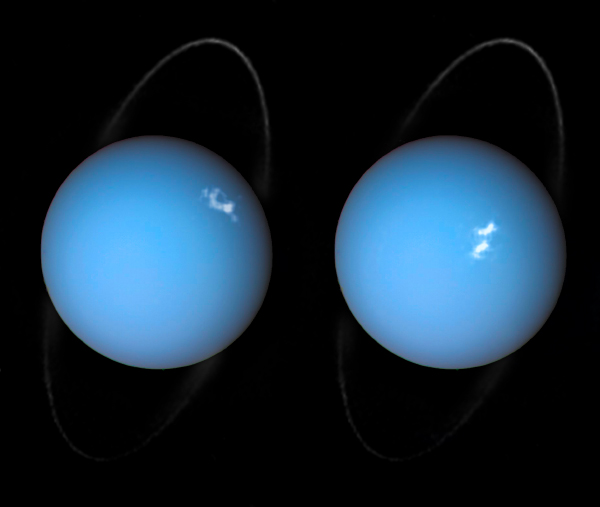
The aurorae observed on magentic planets such as the Earth are the result of an interaction between the energetic electrons emerging from the magnetic environment of the planet - its magnetosphere - and its upper atmosphere. These luminous emissions produced by fluorescene (as in our ordinary "twisted bulbs") furnish invaluable information about the active regions of the magnetosphere.
The observations of polar aurorae on Uranus are very rare. The first of their kind were realized in January 1986 by Voyager 2’s ultraviolet spectropmeterpar, during its fflyby of the planet, then at solstice. The probe revealed a magnetospherre unlike any other in the Solar System. In effect, the planet’s rotation axis lies close to the ecliptic plane, while the magnetic axis is inclined at 60°, and the planet rotates rapidly with a period of 17,24 h.
Due to the lack of probes going to Uranus, its aurorae were only observed again in 25 years later, in 2011, using an ultraviolet camera on the Hubble (NASA/ESA) space telescope. This result was obtained by a scientific team led by Laurent Lamy, astronomer at the Paris Observatory, using a quite original technique : the observations were programmed to take place during the passage of the shock waves in the solar wind, which is known to activate aurorae on other planets and is predicted by numerical models . The astronomer were thus able to obtain the first images of the two rarefied aurorae on Uranus soon afterr equinox.
In the April 3rd 2017 issue of the Journal of Geophysical Research, the same team describes the detection of six new auroral signatures, through pairs of successive images obtained by the Hubble space telescope : the first pair was obtained during an observing campagin in 2012, whose purpose was to study the role of the planet’s rotatlion, and the two others were done in 2014, when the solar wind was particularly active.
On one of the picturres, taken on November 24th 2014, can be seen the brightest aurora ever recorded : the power radiated is in the region of 6-9 gigawatts. These obsevations suggest that even if the birth of the aurorae is a function of the overall geometry of the "magnetosphere – solar wind" system, governed by the planetary rotation, it is also affected by the force of the solar wind.
Thhrough these new observations made from the Earth, the team has shown that the magnetosphere of Uranus can be studied during the planet’s motion around the Sun, and during various seasonal configurations.
« Observing the aurorae and their temporal variations is our only means to study from afar the intriguing asymmetrical magnetosphere of Uranus, as the planet moves arund the Sun/. This gives information about its interaction with the planetary atmosphere, on the one hand, and the solar wind on the other/ », notes Laurent Lamy, first names author of the paper.
This work has enabled one to characterize the mean properties of the uranian aurorae around equinox : they appear as patches on the day side of the planet, they can be intense, they can last for many tens of minutes, and their intensity can vary very significantly, on a time scale of minutes or even seconds.
Furthermore, the scientists were able to fix the positions of the 2014 aurorae with the help of auroral oval models based on the most recent model for the magnetic field of Uranus. This has enabled one to restore the longitude of the magnetic poles of Uranus, lost soon after their discovery in 1986 by Voyager 2 as a consequence of a considerable uncertaintly for the value of the period of rotation of the planet.
Applying this adjustment to the 2011 data and that of 1986 could lead to a new ultra precise value for the period of rotation of Uranus, and thereby impose better constraints on models for planetary formation.
Reference
This work has been published under the title « Uranus’ aurorae past equinox », in the April 3rd 2017 issue of the Journal of Geophysical Research,
doi : 10.1002/2017JA023918
